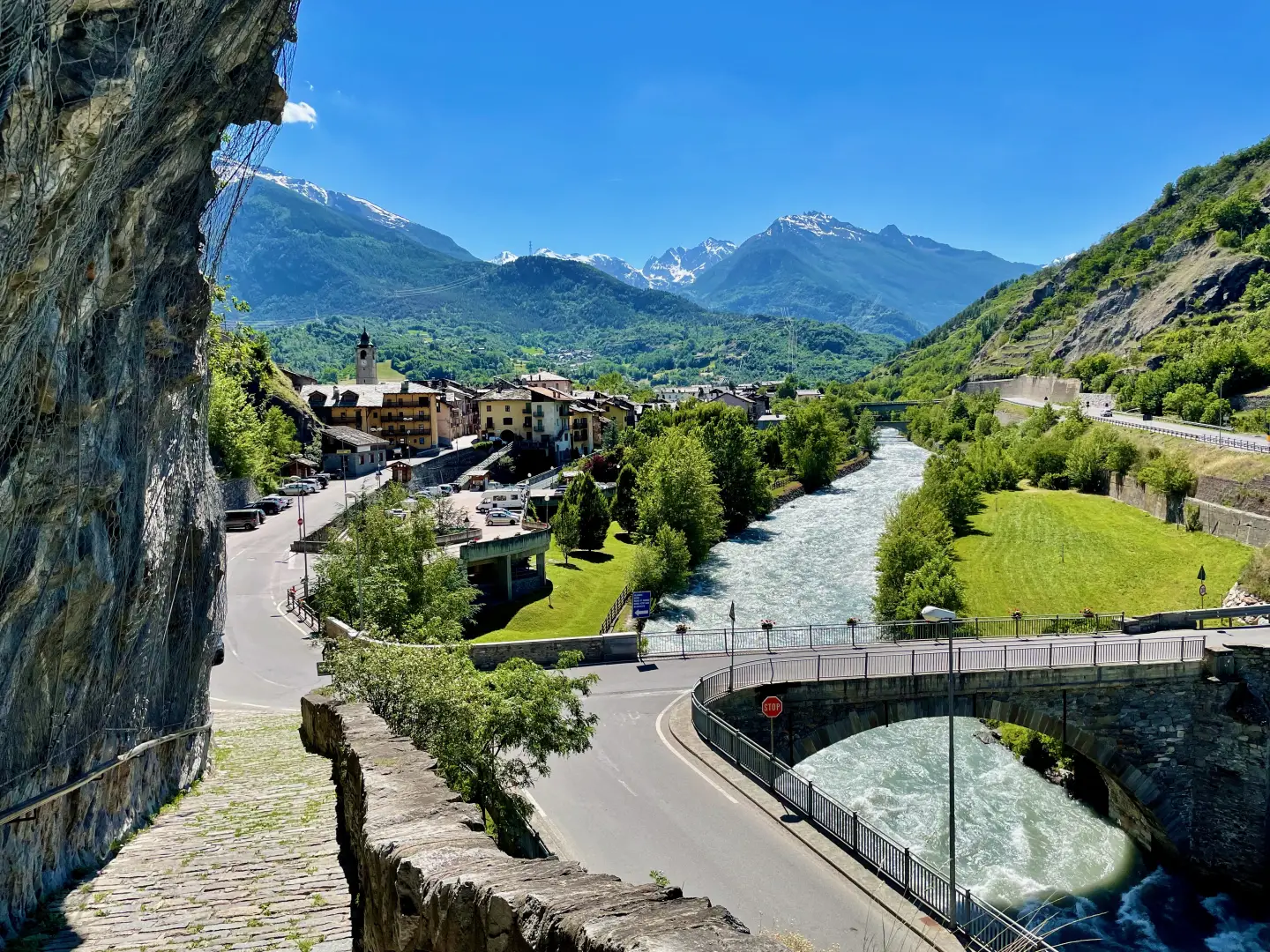Villeneuve

Access
Villeneuve is easy to reach thanks to its strategic location along the Valle d'Aosta state road and the motorway (Aosta East exit). The nearest railway station is Aosta, which is connected to Turin and Milan, from where frequent buses depart for Villeneuve. The most convenient airport is Turin-Caselle, about 120 km away, while Milan-Malpensa is 180 km away. The local road network allows easy access to all hamlets and points of interest.
.Introduction
Villeneuve is a small mountain municipality in Valle d'Aosta, located in the valley bottom of the Dora Baltea a few kilometres west of the regional capital, Aosta. Its name, 'new villa', suggests a repeated historical reconstruction, perhaps linked to the numerous floods that have changed its layout over time. Today, the village is a dynamic and interesting reality, with a historical heritage rooted in prehistory and an identity linked to the surrounding river and mountain landscape. The presence of the ruins of the mediaeval castle of Châtel-Argent, also clearly visible from the neighbouring towns, recounts its strategic past, while the current tourist and sports vocation renews its cultural and environmental vitality.
Description
Set amidst the folds of the upper Dora Baltea Valley, Villeneuve lies at an altitude of 670 metres in an area where the valley widens out, offering broad and bright views. The landscape is dominated by the rocky ridges that rise towards the side valleys of Rhêmes and Valsavarenche, at the gateway to the Gran Paradiso National Park. The municipal territory, although small in size, offers a mosaic of environments: sunny slopes cultivated with vineyards, broadleaf forests, floodplain areas and rocky areas. It is precisely the Dora Baltea, with its impetuous course and spectacular rapids, that constitutes one of the most characteristic natural elements of the municipality, which has become a magnet for lovers of river sports.
Villeneuve boasts a very ancient human presence: in 1917, during work on a hydroelectric power station, 25 Aeneolithic tombs came to light, bearing witness to settlements dating back over 4000 years. The period of greatest historical importance, however, lies in the Middle Ages, with the construction of the Châtel-Argent castle in the 13th century. Its position, on a spur dominating the village, made it the centre of a vast seigniory extending from the Petit St Bernard to the outskirts of Aosta. The castle even housed a mint and its 15-metre donjon, still well-preserved today, dominates a sweeping panorama encompassing the entire valley. This fortress was the heart of power, justice and control of Alpine transits.
During the 19th century, Villeneuve experienced a phase of industrial transformation, with the opening of a foundry that processed iron from the Cogne mines. This activity profoundly marked the economic life of the village for many decades, favouring a partial urbanisation of the territory. In contemporary times, the local economy has been reconverted mainly towards agriculture and tourism. Today, quality dairy production goes hand in hand with outdoor experiences that take advantage of the presence of the Dora Baltea river and the nearby Gran Paradiso valleys. Rafting, kayaking and hydrospeeding are just some of the activities that can be practised thanks to the conformation of the river and the presence of specialised facilities.
The cultural and social life of the municipality is linked to deep-rooted traditions and shared festive moments. The patron saint is Saint Blaise, celebrated at the beginning of February with a feast involving the entire community. The local cuisine offers rustic and genuine flavours, linked to Valle d'Aosta tradition: alpine cheeses, black bread, polenta and game are the protagonists of the tables during convivial moments and festivals. There is no lack of craftsmanship that keeps ancient skills alive, such as woodworking and the production of soapstone objects.
In terms of hiking, Villeneuve is a strategic base for exploring the lateral valleys of Rhêmes and Valsavarenche, privileged accesses to the Gran Paradiso National Park. Numerous trails branch off from the village, reaching alpine pastures, alpine lakes and panoramic viewpoints of extraordinary beauty. In addition to the nature hikes, the ascent to the Châtel-Argent castle is a short but suggestive walk offering a 360-degree view of the valley floor. The didactic trails and activities offered by the nearby park also bring families and schools closer to the environmental heritage.
Information
Area: 8.80km²
Altitude: 760m
Maximum elevation: 2,267m - slopes of Becca Piana
Number of inhabitants: 1,304 as of 31.12.24
Name in dialect: Veullanoua in Valle d'Aosta patois
Inhabitants name: Villeneuviens
Patron saint: Saint Blaise, celebrated on 3 February and St. Mary of the Assumption celebrated on 15 August
Bordering municipalities: Arvier, Aymavilles, Introd,Saint-Nicolas, Saint-Pierre,Valsavarenche
Website: www.comune.villeneuve.ao.it